Tall Tales and
Short Shorts
Sports Icons and Issues in Popular Culture
Series Editors
Bob Batchelor and Norma Jones
In an age when sports icons cross over into everyday lives and popular culture, the time is ripe for assessing, reassessing, and refocusing our gaze on the significance of athletes in the contemporary world. The Sports Icons and Issues in Popular Culture series engages with star athletes and significant sports issues to examine how they have influenced not just the sporting world, but also popular culture and society. By looking beyond the on-field stats and figures, this series helps readers further understand sports icons both as individuals and as cultural phenomena.
Titles in the Series
Tall Tales and Short Shorts: Dr. J, Pistol Pete, and the Birth of the Modern NBA by Adam J. Criblez
Tall Tales and
Short Shorts
Dr. J, Pistol Pete, and
the Birth of the Modern NBA
Adam J. Criblez
ROWMAN & LITTLEFIELD
Lanham Boulder New York London
Published by Rowman & Littlefield
A wholly owned subsidiary of The Rowman & Littlefield Publishing Group, Inc.
4501 Forbes Boulevard, Suite 200, Lanham, Maryland 20706
www.rowman.com
Unit A, Whitacre Mews, 26-34 Stannary Street, London SE11 4AB
Copyright 2017 by Rowman & Littlefield
All rights reserved. No part of this book may be reproduced in any form or by any electronic or mechanical means, including information storage and retrieval systems, without written permission from the publisher, except by a reviewer who may quote passages in a review.
British Library Cataloguing in Publication Information Available
Library of Congress Cataloging-in-Publication Data
Name: Criblez, Adam, author.
Title: Tall tales and short shorts : Dr. J, Pistol Pete, and the birth of the modern NBA / Adam J. Criblez.
Description: Lanham : ROWMAN & LITTLEFIELD, [2017] | Series: Sports Icons and Issues in Popular Culture | Includes bibliographical references and index. | Description based on print version record and CIP data provided by publisher; resource not viewed.
Identifiers: LCCN 2016041918 (print) | LCCN 2017011541 (ebook) | ISBN 9781442277687 (electronic) | ISBN 9781442277670 (hardcover : alk. paper)
Subjects: LCSH: National Basketball AssociationHistory. | Basketball playersUnited StatesAnecdotes. | BasketballUnited StatesHistory.
Classification: LCC GV885.515.N37 (ebook) | LCC GV885.515.N37 C75 2017 (print) | DDC 796.323/64dc23
LC record available at https://lccn.loc.gov/2016041918
 TM The paper used in this publication meets the minimum requirements of American National Standard for Information Sciences Permanence of Paper for Printed Library Materials, ANSI/NISO Z39.48-1992.
TM The paper used in this publication meets the minimum requirements of American National Standard for Information Sciences Permanence of Paper for Printed Library Materials, ANSI/NISO Z39.48-1992.
Printed in the United States of America
All images Larry Berman
Acknowledgments
Writing is a solitary process. But despite spending many hours alone at my computer composing, editing, and rewriting, I am also incredibly fortunate to have had tremendous support along the way.
First, I have to thank my editor at Rowman & Littlefield, Christen Karniski, and the series editors, Bob Batchelor and Norma Jones. Their feedback has helped me focus on important topics and themes, and my book is much better because of their input.
This project began three years ago when I took a trip to Springfield, Massachusetts, the home of the Naismith Memorial Basketball Hall of Fame. During my visit, I had the opportunity to meet Matt Zeysing, the curator and historian. Matt and his crew provided some great ideas and helped me shape this book at an early stage.
A big thanks to my colleagues at Southeast Missouri State University. In particular, my department chair, Wayne Bowen, has supported my work on this book and helped me develop a course on sports history as a result of my research. And Susan Welker, from Southeasts Kent Library, has gone above and beyond to track down hard-to-find books, magazines, and microfilm.
Although my Ph.D. work was in nineteenth-century social and cultural history, I have found sports historians unbelievably welcoming as I invaded their turf. In particular, Aram Goudsouzian, Aaron Haberman, and Johnny Smith have given me fantastic advice and become good friends along the way.
The Internet has made connecting with other hoop-o-philes easier than ever. I have not met Shawn Fury, Jason Mann, Rich Kraetsch, or Todd Spehr in person, but all are passionate about basketball history and have helped my research and writing. Matt Love, another Internet connection, hooked me up with terrific audio files from the Trail Blazers 1977 championship run, and Stanley Radzicki provided dozens of videos so I could watch a little fabulous footage from the era.
I was fortunate to stumble onto Larry Bermans photography website (bermansports.com) through a random Internet search, and he graciously agreed to provide the images for both the cover and the interior of this book. His photographs are top notch and truly bring this story to life.
And finally, my biggest thank you goes out to my family, especially my wonderful wife Jennie and our three daughters: Avery, Eliza, and Charlotte. Thank you for tolerating hours of vintage NBA video marathons. Thank you for understanding why I had to spend many evenings and weekends researching and writing. And thank you, most of all, for your love.
Pregame
The 1969 Finals
In January 1970, Americans flocked to theaters to watch the dark comedy M*A*S*H, starring Donald Sutherland as Captain Benjamin Hawkeye Pierce; they swayed in time to B. J. Thomass Raindrops Keep Fallin on My Head; they cheered for the Kansas City Chiefs (or the Minnesota Vikings, poor saps) in Super Bowl IV; and some even watched professional basketball. In the first NBA game played in the 1970s, Chet the Jet Walker and the visiting Chicago Bulls outscored the Seattle SuperSonics by eight points in the final minute to escape with a 114111 win.
Most Americans celebrated the beginning of the new decade on the first of January. But by the time of the Bulls comeback win in Seattle, basketball fans were already in midseason form. In fact, August 4, 1969 (just two weeks after Neil Armstrong took his famous giant leap for mankind), was the real start of the seventies in the NBA. That day, a new issue of Sports Illustrated hit newsstands carrying a surprising headline: Bill Russell was retiring as the player-coach of the Boston Celtics. Since 1943, when I first saw a basketball, Russell explained in the exclusive interview, Ive played approximately 3,000 games, organized and otherwise. I think thats enough. Russells announcement shocked the basketball world. Celtics president Red Auerbach tried to convince him to reconsider, but the eleven-time champ had made up his mind. He was done.
For thirteen years, Bill Russell and the Boston Celtics were synonymous with professional basketball. When Russell entered the league in 1956, most teams played a below-the-rim, slow-paced game relying on patterned ball movement and plodding centers like Minneapolis Lakers star George Mikan. Russells incredible athleticism allowed the Celtics to employ a fast-breaking style that revolutionized the game. Auerbach, the stogie-smoking architect of those Celtics teams, surrounded Russell with exceptionally skilled role players. Bob Cousy (and later K. C. Jones) handled the ball and ran the offense while Bill Sharman (and then Sam Jones) served as designated shooters. In the forward slotscalled cornermen in the 60s and 70sthe Celtics trotted out Tom Satch Sanders as the defensive stopper and Tom Tommy Gun Heinsohn as another scoring threat. The Celtics also benefitted from tremendous depth as, for most of Russells career, the team employed their second-best forward as a sixth man, with future Hall of Famers Frank Ramsey and John Havlicek thriving as substitutes.

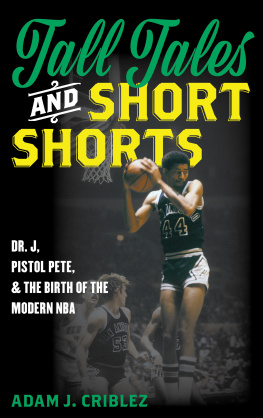
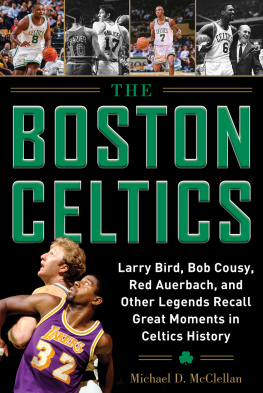
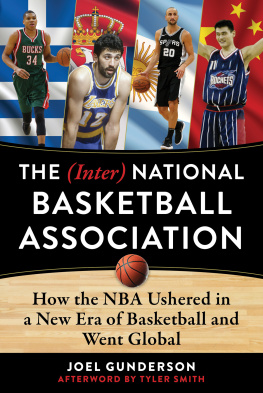


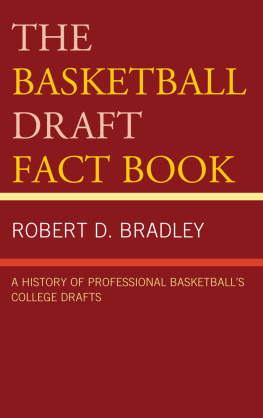

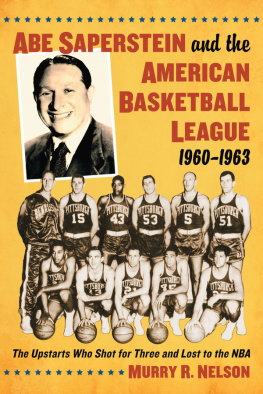
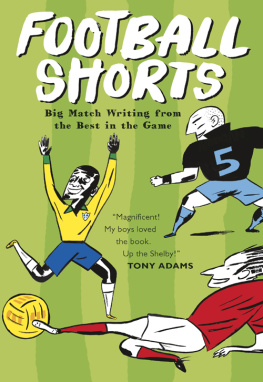
 TM The paper used in this publication meets the minimum requirements of American National Standard for Information Sciences Permanence of Paper for Printed Library Materials, ANSI/NISO Z39.48-1992.
TM The paper used in this publication meets the minimum requirements of American National Standard for Information Sciences Permanence of Paper for Printed Library Materials, ANSI/NISO Z39.48-1992.